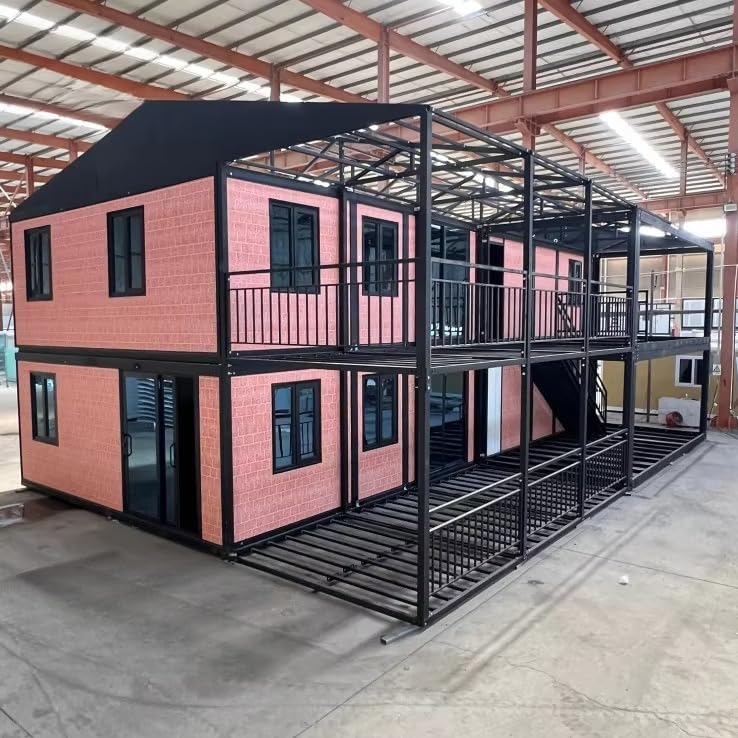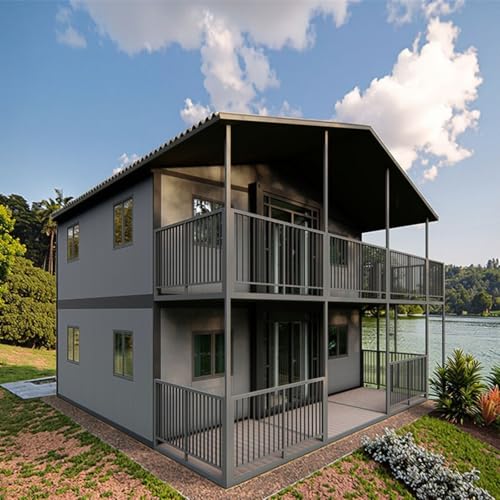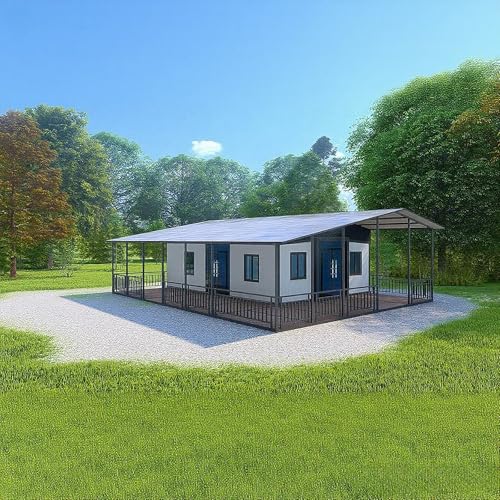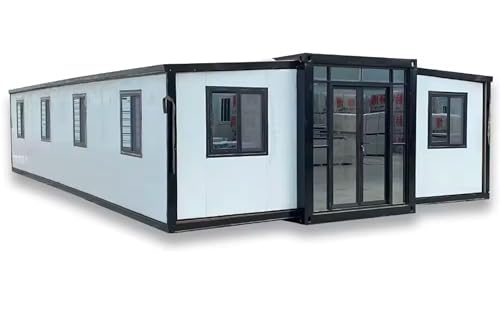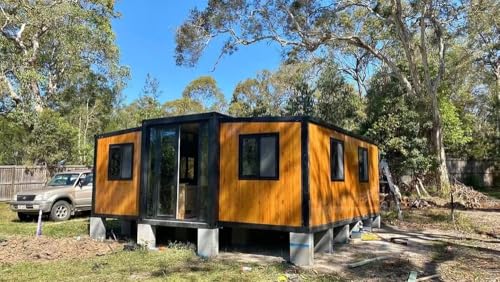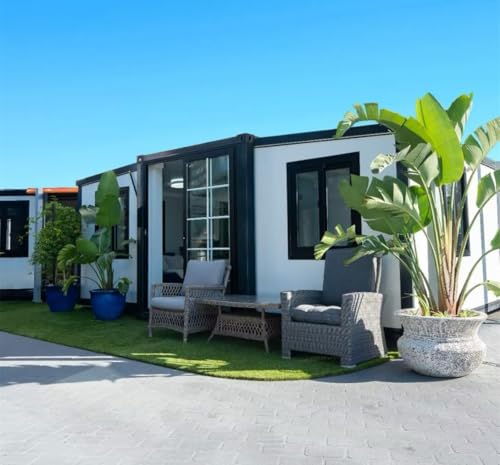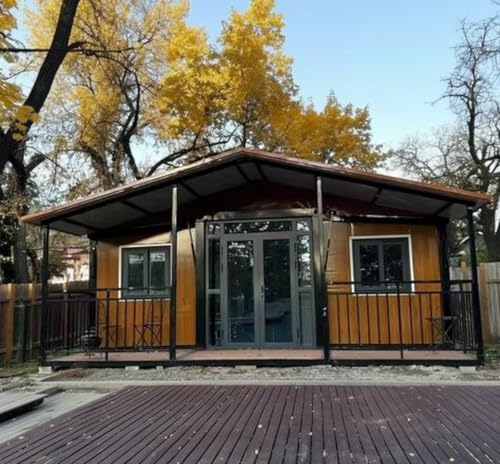- 【Versatile Use Cases】: Designed for multiple applications, this foldable house serves as a temporary home, garden office, or event space. This foldable house can function as a guest room, studio, or retail booth, adapting to changing needs. Its adaptable layout accommodates various needs, from vacation stays to commercial uses.
- 【Customizable Options Available】: You can personalize this foldable house like windows, doors, or layouts to suit specific needs. For more details or inquiries, please contact us before placing an order.
- 【Quick and Easy Assembly】: Assembling this foldable house is quick and straightforward, requiring no specialized tools or skills. The intuitive design includes pre-attached components and clear instructions, enabling setup in under an hour. This makes it perfect for urgent situations or temporary use, such as disaster relief or backyard offices.
- Versatile Use: The Double story flat pack house serves multiple purposes, It is easy to move and can be used for various purposes, from your home to motels and offices, etc. meeting various lifestyle needs.
- Robust Construction: Crafted from resilient steel, the structure ensures durability and security, with lockable doors and windows for safety.
- Essential Amenities: The dwelling includes essential amenities like a fully equipped bathroom and kitchen cabinets, ensuring a comfortable living experience.
- Spacious 2-Bedroom Design – This modular container home offers comfortable living with two spacious bedrooms, ideal for families, couples, or even as a guest house.
- Fully Equipped Kitchen – Enjoy a complete kitchen setup featuring modern appliances, ample counter space, and storage—perfect for cooking and entertaining.
- Eco-Friendly Build – Crafted from high-quality, durable shipping containers, this home is built to withstand the elements while offering a sustainable living solution.
- Warm Reminder: This product offers a range of customisable styles and accessories. For more details or enquiries, we recommend that you leave us a message or contact us via +➑➏ ➊➎➑ ➌➐➊⓿ ➐➑➒➏ before purchasing
- Super Convenient: Prefab folding houses are all about convenience! They come pre-assembled and ready to set up in no time. Just unfold and enjoy your new space without the hassle of traditional construction.
- Space-Saver Extraordinaire: These homes are designed to maximize every inch! Perfect for tiny living enthusiasts or urban dwellers, they offer smart layouts that make small spaces feel big and functional, turning even compact areas into cozy retreats.
- Please note that the prices listed are not final. This product offers a range of customisable styles and accessories. For more details or enquiries, we recommend that you leave us a message before purchasing.
- Dimensions: Length20xWidth20xHeight8.3ft
- Accomadating : 2 bedrooms, 1 kitchen, 1 living room, 1 bathroom or custom layout
- Customizable Options: Foldable houses can be customized to meet specific needs, including the interior layout, size, and features so the final price is according to your needs. Please feel free to CONTACT us via WhatsApp at +86 15093175368 before placing an order for more information!!
- Quick construction: The standardized container size and simple installation process only require necessary internal decoration and connection and fixing to quickly complete the house construction, greatly shortening the construction period and being able to be put into use quickly.
- Sturdy and stable: The container is based on the old container. The container itself is made of high-strength steel, with a solid structure, excellent earthquake resistance, pressure resistance and wind resistance, ensuring living safety.
- Warm Reminder: Listed prices are for reference only (base cost of the 20ft houses main structure, shipping not included). Our products support custom styles/accessories, with specific prices varying by your configuration do not place orders directly.. For more details, contact us via WhatsApp +86 136 0606 3589 To ensure your satisfaction
- This expandable container house features a durable galvanized steel structure. It boasts a fireproof rating of A grade, wind-resistant and anti-seismic ratings of 10 grade, and a service life of 20 years. Certified by CE and WaterMark, ensuring compliance with international safety and quality standards, it provides market access and buyer confidence. The house is pre-installed, supports fast installation within 2 hours, and includes electrical systems compliant with 3C/CE/CL/SAA standards
- Wide range of uses: Suitable for offices, living spaces, storage rooms, lounges, etc., create your own oasis with this modern outdoor cabin to adapt to various needs
- Note: This product comes in various models and offers customization support. The prices listed are for reference only(Basic version, shipping not included); the actual price will vary based on your chosen model and customization needs. For further details (e.G., model specs, custom requirements), please contact us directly via whatsapp at +86 136 0606 3589
- Size Variants:Available in size 40ft/30ft/20ft size Suitable for a variety of uses, from residential to commercial Customizable Design:Interior and exterior customization available Choose paint colors and floor finishes to suit your style
- Quality Assurance: Manufactured to high standards for durability and reliability waterproof, suitable for all types of weather conditions Backed by quality assurance guarantees for peace of mind
- Customize your container home with pricing based on size, layout, configuration, and distance—listed prices are not final(base cost of the 20ft houses main structure, shipping not included)). Our products support custom styles/accessories, with specific prices varying by your configuration do not place orders directly.. For more information, videos, or assistance, leave a message before ordering or contact us on WhatsApp at +86 136 0606 3589. We’d love to help
- This expandable container house features a durable galvanized steel structure. It boasts a fireproof rating of A grade, wind-resistant and anti-seismic ratings of 10 grade, and a service life of 20 years. Certified by CE and WaterMark, ensuring compliance with international safety and quality standards, it provides market access and buyer confidence. The house is pre-installed, supports fast installation within 2 hours, and includes electrical systems compliant with 3C/CE/CL/SAA standards
- Wide range of uses: Suitable for offices, living spaces, storage rooms, lounges, etc., create your own oasis with this modern outdoor cabin to adapt to various needs
- ❤【Kind Reminder】Please note that the prices listed are only the base price for the main structure. If you need to add kitchen or bathroom accessories, please let us know, as the price will be different. Please do not place an order directly. +8619030380970
- 🛠【Quick Installation Design】This tiny homes adopts an innovative modular snap-on system that requires no professional tools or construction experience. It can be assembled by four person in just three hours. Detailed video tutorials and illustrated manuals are provided to ensure a simple and worry-free installation process, truly delivering the convenience of a ready-to-move-in experience.
- 🏠【Multi-functional Usage Scenarios】From home backyard offices and children’s playrooms to commercial mobile shops, construction site dormitories, and even emergency disaster relief sites, this folding house can adapt perfectly and flexibly meet your diverse space needs.
- Warm Reminder: Please note that this is the price per 1FT. Our products support custom styles/accessories, with specific prices varying by your configuration do not place orders directly.. For more details, contact us via WhatsApp +86 136 0606 3589 To ensure your satisfaction
- Customizable Options – Available in 20ft/30ft/40ft sizes with 1–4 room layouts. Price shown is for reference only—contact us for accurate quotes, videos, and personalized design plans
- Quick Installation Design – Pre-installed modular home allow easy on-site assembly, no need for professional construction tools or complex operations. Expandable modular home cuts down assembly time by 60% and reduces labor costs, enabling immediate use after setup
- Dimensions: 36’x 8’ with 288 sq ft of living space
- Features: Bed/couch area, kitchen, storage, washroom with shower
- Loft Areas: Two lofts, one with a bed
- Mini Home: Your favorite home brands turned Mini; including KitchenAid, Sistema, Black+Decker, and MasterChef!
- Rare Minis: Can you find the legendary rare Minis with included resin?
- 60+ Minis: There are over 60+ Home Minis to collect!
- Miniature Dollhouse Kit:This doll house is not just a toy, but a building or home decoration that can be stored after completion. It come with parts, need to assemble DIY. The assembly is suitable for people older than 14 years, a great way to communicate with teenagers or adults and perfect project for spending time.
- Easy to Assemble: Safe, Non-toxic, highest quality materials are almost similar to the real room including wood, plastic, cloth, paper. There is English instruction and detailed picture, easy to understand and follow. Just need your time and patience to painting, sticking, assembling and glue all pieces together.
- Fun Crafting Project: DIY the dollhouse needs patience and time, it normally takes 10-15 hours to finish it. You will get lots of sense of accomplishment after finishing the enjoyable project.
The tiny home movement continues to captivate people seeking a simpler, more sustainable lifestyle. From charming cottages to innovative modern designs, these compact dwellings prove that less square footage doesn’t mean sacrificing style, comfort, or functionality.
Shingled Cottage
Classic shingled cottages embody timeless coastal charm in compact footprints. These homes feature weather-resistant cedar shakes that age beautifully over time, creating character-rich exteriors that blend seamlessly with natural surroundings. Inside, vaulted ceilings and strategic window placement maximize natural light, making even the smallest spaces feel open and airy. The shingled aesthetic works particularly well for tiny homes because the texture adds visual interest without overwhelming the modest scale.
Matching “Granny Pod”
Accessory dwelling units, often called granny pods or in-law cottages, provide independent living spaces designed with safety and accessibility in mind. These tiny freestanding homes are built behind primary residences to accommodate aging parents or provide multigenerational living options. Modern granny pods feature wide doorways, zero-threshold entries, grab bars in bathrooms, and open floor plans that accommodate mobility devices. Some versions include high-tech medical monitoring systems and emergency response features integrated into smart home technology.
Clapboard Cottage
Traditional clapboard siding brings New England charm to tiny home designs. The horizontal lap siding creates clean lines that complement both coastal and countryside settings. These cottages typically feature symmetrical facades, multi-pane windows, and simple rooflines that maximize interior ceiling height. The classic clapboard aesthetic translates beautifully to smaller scales, offering a traditional look that never goes out of style while providing excellent weather protection.
Seaside Homestead
Coastal tiny homes embrace their oceanfront locations with design elements that celebrate sea and sky. Large windows frame water views, while covered porches extend living space outdoors. Weatherproof materials like composite decking, marine-grade hardware, and corrosion-resistant fixtures ensure longevity in salty air environments. Seaside homesteads often incorporate nautical design touches like ship lap walls, porthole windows, and blue-and-white color schemes that echo the surrounding seascape.
Beach Cottage
Beach cottages pack maximum coastal charm into minimal square footage. These sun-bleached sanctuaries feature open floor plans that blur indoor-outdoor boundaries, making compact spaces feel expansive. Outdoor showers, sandy-foot-friendly flooring, and built-in beach gear storage accommodate the coastal lifestyle. Light color palettes, natural textures, and breeze-catching window configurations create relaxed atmospheres perfect for vacation retreats or year-round coastal living.
Modern Farmhouse
The modern farmhouse aesthetic brings rustic charm with contemporary clean lines to tiny home design. Exposed wood beams, shiplap accent walls, and barn-style doors add character while maintaining the simplicity essential for small-space living. Neutral color palettes with black metal accents create visual interest without cluttering tight quarters. These homes often feature gabled roofs, front porches, and board-and-batten siding that reference traditional agricultural buildings updated for modern sensibilities.
Rustic Cabin
Rustic cabin-style tiny homes embrace natural materials and wilderness settings. Reclaimed wood, stone accents, and timber framing create cozy retreats that feel connected to nature. Wood-burning stoves or fireplaces serve as focal points while providing efficient heating. Large windows frame forest or mountain views, bringing the outdoors in. Despite compact dimensions, these cabins achieve the warm, inviting atmosphere of traditional hunting lodges through careful material selection and thoughtful design.
Boat House
Converted boathouses offer unique waterfront living opportunities in extremely compact packages. These structures, originally built to store boats, transform into charming tiny homes with character-rich bones. Exposed beams, water views from multiple sides, and direct dock access make boathouse conversions special. The proximity to water requires moisture-resistant materials and proper ventilation, but the payoff is unmatched waterfront access and one-of-a-kind living spaces.
Converted Schoolhouse
Historic schoolhouses find new life as tiny homes, preserving architectural heritage while creating unique living spaces. High ceilings with original chalkboards, large windows that once lit student desks, and hardwood floors tell stories of their educational past. These conversions maintain period details like wainscoting and vintage hardware while incorporating modern amenities. The generous ceiling heights of old schoolhouses make them feel more spacious than their square footage suggests.
Antiques-Filled Bungalow
Craftsman-style bungalows embrace built-in storage, handcrafted details, and vintage charm. These tiny homes feature original built-in bookcases, window seats with hidden storage, and craftsman-era light fixtures. The bungalow style naturally accommodates small-space living through efficient layouts and multifunctional spaces. Period furnishings and architectural salvage pieces add character while honoring the home’s heritage aesthetic.
Converted Boathouse
Waterside boathouse conversions maximize spectacular water access in ultra-compact footprints. Original boat slips sometimes remain, allowing residents to literally park their kayaks or small boats under their homes. Large doors that once admitted boats become dramatic architectural features, often converted to walls of windows or folding glass doors. The industrial bones of working boathouses—exposed trusses, weathered wood, nautical hardware—create distinctive interiors impossible to replicate in new construction.
Restored Folk Victorian
Folk Victorian homes bring ornate detailing and historical charm to tiny house living. Decorative trim work, spindle details, and colorful paint schemes create visually rich exteriors despite modest dimensions. These homes often feature steep rooflines with dormers that add upstairs space and architectural interest. Period-appropriate restoration preserves historical character while updating systems and insulation for modern comfort and efficiency.
Bucolic Cottage
English cottage-style tiny homes embrace storybook charm with thatched or steeply pitched roofs, stone or brick facades, and abundant gardens. Arched doorways, diamond-pane windows, and climbing roses create fairytale aesthetics. Despite compact interiors, these cottages feel cozy rather than cramped through low ceilings with exposed beams, inglenook fireplaces, and warm color palettes. The cottage garden tradition extends living space outdoors, providing additional rooms in good weather.
Saltbox Farmhouse
Historic saltbox-style homes offer distinctive profiles with their characteristic long, sloping rear rooflines. This traditional New England form actually benefits tiny home design by maximizing ceiling height in main living areas while creating useful shed-roof spaces for bedrooms or storage. The simple rectangular footprint uses space efficiently, and the classic silhouette provides instant architectural character. Saltbox designs historically emphasized practicality—a philosophy perfectly aligned with tiny house values.
Cozy Lake House
Lakefront tiny homes balance compact living with waterfront recreation. Large decks effectively double living space during warm months, while interior spaces focus on essentials—sleeping areas, compact kitchens, and comfortable gathering spots. Expansive windows frame lake views, making interiors feel connected to the water. Kayak storage, fishing rod racks, and outdoor gear organization accommodate lake life within limited square footage.
Rustic Retreat
Remote rustic retreats embrace off-grid capabilities and wilderness solitude. Solar panels, rainwater collection, and composting toilets allow these tiny homes to exist far from utilities. Natural materials like log siding, stone, and rough-hewn timbers blend structures into forest settings. Minimal square footage reduces environmental impact while still providing shelter, warmth, and comfort in nature. These retreats prove that small can mean self-sufficient.
Grain Silo Guest House
Agricultural silos transform into distinctive round tiny homes with unique spatial qualities. The cylindrical form creates continuous curved walls that eliminate corners, making small spaces feel more open. Original metal siding provides industrial aesthetic and excellent durability. Spiral staircases efficiently connect multiple levels within the narrow footprint. Large circular windows can be cut into the curved walls, and the iconic farm structure silhouette makes powerful architectural statements.
Open Air Living Room
Tiny homes with retractable walls or folding glass doors transform completely when opened to the outdoors. These designs recognize that outdoor space expands the tiny footprint dramatically when weather permits. Large overhangs and covered porches create transitional zones between inside and out. Interior finishes extend onto decks or patios, blurring boundaries. This indoor-outdoor living approach effectively multiplies usable square footage during pleasant weather.
Coastal Cottage
Weathered coastal cottages embrace casual elegance and salt air patina. Natural materials age gracefully in marine environments, developing silver-gray tones that echo driftwood and beach grass. Modest footprints keep focus on ocean views and outdoor living. Built-in benches, window seats, and storage solutions maximize limited interior space. Coastal color palettes of blues, whites, and sandy neutrals keep tiny interiors feeling fresh and spacious.
A Jewel of a Home
Meticulously detailed tiny homes achieve jewelry-box elegance through exceptional craftsmanship and premium materials. Custom millwork, designer fixtures, and luxury finishes transform small spaces into sophisticated retreats. Every surface, from hand-painted tiles to custom cabinetry, receives careful consideration. These homes prove that tiny doesn’t mean basic—skilled design and quality materials create spaces that feel special rather than spare.
Dynamic Duo
Paired tiny structures create flexible living arrangements—perhaps a main cottage with separate studio, or side-by-side dwellings for multigenerational families. This approach allows more total living space while maintaining individual compact footprints that may meet zoning requirements more easily. Shared outdoor spaces connect the structures, while separate entrances provide privacy. The dynamic duo concept offers flexibility for evolving needs and visiting guests.
Greenhouse Meets Tree House
Combining greenhouse principles with elevated structures creates unique tiny homes filled with light and surrounded by nature. Extensive glazing on south-facing walls provides passive solar heating while creating garden room atmospheres. Lofted positions in tree canopies offer privacy and views while minimizing site disturbance. These hybrid designs merge sustainable building strategies with the romance of treehouse living.
Gorgeous Backyard Getaway
Backyard tiny homes provide peaceful retreats steps from main houses. These accessory dwelling units serve as home offices, art studios, meditation spaces, or guest quarters. Their modest size makes them achievable DIY projects or affordable additions. Separate structures offer mental separation from main household activities while remaining convenient. Well-designed backyard cottages add property value and functionality.
A Backyard Art Barn
Creative studios require good light, storage for supplies, and inspiring atmospheres—all achievable in compact structures. North-facing windows provide consistent natural light for visual arts. High ceilings accommodate large canvases or sculpture. Simple, durable finishes withstand messy creative processes. These tiny art barns prove that dedicated creative space doesn’t require vast square footage—just thoughtful design that supports the work.
Shack by the Sea
Casual beach shacks embrace rustic simplicity and coastal living at its most elemental. Minimal amenities, rough finishes, and basic shelter from the elements define these ultra-compact retreats. The focus remains on beach access and outdoor living rather than interior luxury. Simple board-and-batten construction, outdoor showers, and sandy floors acknowledge that the beach itself is the main living space.
Towering Tree House
Elevated tiny homes perched in trees offer childhood dreams realized. Structural considerations for tree movement, minimized trunk damage, and access solutions create unique engineering challenges. Views from the canopy, privacy from elevation, and connection with nature reward the complexity. Platform designs distribute weight across multiple trees or combine tree and post support systems for stability.
Quaint Little Cabin
No-frills cabins strip living to essentials—shelter, warmth, basic comfort. Single rooms with sleeping lofts, minimal kitchens, and simple bathrooms keep construction costs low and maintenance minimal. Wood heat, basic lighting, and fundamental furniture allow these cabins to function as weekend retreats or seasonal accommodations. The quaint aesthetic comes from proportion and simplicity rather than decorative elements.
Channel a Little Practical Magic
Cottages inspired by storybook aesthetics and magical thinking embrace whimsy and charm. Asymmetrical rooflines, unexpected architectural details, curved doorways, and fanciful gardens create enchanting atmospheres. These homes prove that tiny spaces can transport inhabitants to imaginary worlds through thoughtful design choices. Practical magic means building dreams into limited square footage through creativity rather than scale.
Tip the Scales
Tiny homes built on repurposed shipping scales or unusual foundations create conversation-starting structures. Industrial elements like exposed steel, weathered metal, and mechanical details provide distinctive aesthetic. The concept challenges conventional thinking about foundations and what constitutes suitable building sites. These experimental tiny homes push boundaries of where and how small structures can exist.
Dreamy Treehouse
Sophisticated treehouse designs elevate childhood fantasies into adult retreats. Premium materials, designer interiors, and modern amenities transform platform-in-trees concepts into luxury getaways. Expansive windows and observation decks maximize canopy immersion. Climate control, full bathrooms, and equipped kitchens allow comfortable extended stays. These structures prove that treehouses can provide refined experiences while maintaining wonder and adventure.
Luxury Farmhouse on Wheels
Mobile tiny homes on trailer chassis combine high-end finishes with complete mobility. Custom cabinetry, luxury appliances, designer fixtures, and premium materials create sophisticated interiors despite tiny footprints. Thoughtful engineering ensures travel-worthy construction and weight distribution. These rolling estates prove that wheels don’t require sacrificing style or comfort.
Charming California Bungalow
California bungalows bring Arts and Crafts philosophy to tiny home design. Exposed rafters, built-in furniture, handcrafted details, and natural materials create warm, human-scaled spaces. Wide eaves and front porches extend living areas outdoors—essential in tiny homes. The bungalow emphasis on built-in storage and multifunctional spaces aligns perfectly with small-space living requirements.
Reclaimed Wood Cabin on Stilts
Elevated cabins on piers minimize site disturbance while providing flood protection and enhanced views. Reclaimed barn wood, salvaged timbers, and architectural antiques create structures with soul and history. The visible foundation framework becomes architectural feature rather than hidden infrastructure. Raising structures on stilts also improves ventilation and deters pests in certain climates.
Mountain Cabin
Alpine tiny cabins withstand harsh weather while providing cozy retreats. Steep roof pitches shed heavy snow loads, while small footprints reduce heating requirements. Thick insulation, efficient wood stoves, and south-facing windows create warm interiors in cold climates. Stone foundations, durable siding, and robust construction details ensure mountain cabins endure challenging conditions while maintaining inviting interiors.
Adorable A-Frame Cabin
A-frame structures maximize ceiling height in compact footprints through their distinctive triangular profile. The steeply pitched roofline naturally sheds snow and rain while creating dramatic interior volumes. Loft sleeping areas tuck into the peaked roof space, leaving main floors open. Large window walls at gable ends bring views and light deep into the narrow structure. A-frames deliver maximum architectural impact from minimal square footage.
Music Lover’s Tiny Home
Tiny homes designed for musicians incorporate soundproofing, instrument storage, and acoustic considerations into compact packages. Built-in instrument racks, music equipment storage, and dedicated practice spaces accommodate musical lifestyles. Acoustic treatments and sound isolation protect neighbors while allowing musical expression. These specialized tiny homes prove that passionate pursuits can shape small-space design.
A Greenhouse Tiny Home
Greenhouse-integrated tiny homes surround living spaces with growing areas. Passive solar heating from south-facing glass walls reduces energy costs while creating garden room atmospheres. Built-in planters, hydroponic systems, and climate control allow year-round food production. The connection with plants and natural light creates healthful living environments. These homes merge sustainable living with biophilic design principles.
Tiny But Mighty
Deceptively spacious tiny homes achieve remarkable functionality through expert planning. Every inch serves multiple purposes—stairs contain storage, furniture folds away, and rooms transform for different uses. Smart layouts, clever built-ins, and visual tricks make compact spaces feel surprisingly roomy. These homes prove that size matters less than thoughtful design.
Small Yet Spacious
Open floor plans, vaulted ceilings, and strategic window placement make tiny homes feel larger than their footprints suggest. Light color palettes reflect available light, while mirrors create depth. Minimal visual clutter and streamlined furnishings maintain open sight lines. These design strategies demonstrate that spaciousness comes from proportion and light rather than square footage alone.
Hidden Storage
Innovative storage solutions transform unused spaces into valuable assets. Stairs become drawers, floors conceal compartments, and furniture hides belongings. Toe-kick drawers under cabinets, storage under stair landings, and pull-out pantries in narrow gaps exemplify creative thinking. Hidden storage maintains clean aesthetics essential in tiny spaces while accommodating belongings.
Tiny Homes
The tiny home movement encompasses diverse structures united by modest footprints and simplified living. Whether mobile or stationary, rustic or modern, these dwellings challenge conventional housing assumptions. Tiny homes prove that quality of life correlates with design thoughtfulness rather than square footage. The movement continues growing as more people discover that living small can mean living large in ways that matter most.
Benefits of Downsizing to a Tiny Home
The appeal of tiny house living extends far beyond cute aesthetics. Over 60% of tiny home dwellers report higher savings than ever before, highlighting the financial freedom this lifestyle offers. Research shows that downsizing to a tiny home can cut your ecological footprint by 45%. Lower utility bills come from smaller spaces requiring less energy for heating, cooling, and lighting, while reduced spending on furnishings means fewer rooms translate to fewer furniture needs.
The psychological impact of downsizing, while initially challenging, often leads to discovering what’s genuinely valuable in life. Embracing minimalism brings clarity and reduces stress from cluttered environments. Many find that living with less actually offers more freedom and time for experiences over maintaining possessions.
Making the Transition Work
Transitioning to tiny home living involves more than downsizing space—it requires reimagining life with intentionality at its core. Start by sorting belongings into categories: keep, donate, sell, or discard. Focus on what you truly need and ask yourself if each item serves a purpose in your tiny home life.
Multi-functional furniture maximizes limited space—storage ottomans, fold-down tables, murphy beds, and convertible sofas all serve dual purposes. Built-in benches can store items while providing seating. Vertical storage solutions like wall-mounted shelves, hanging pot racks, and hooks utilize space that would otherwise go unused.
Design Strategies for Small Spaces
Making every inch count requires thoughtful planning. Lofted sleeping areas free floor space below for living areas or home offices. Stairs to lofts can incorporate storage drawers, creating functional access that doesn’t waste space. Pocket doors and sliding doors save space that swinging doors would consume.
Natural light makes tiny spaces feel more expansive. Skylights, clerestory windows, and strategically placed openings bring daylight deep into compact interiors. Light color palettes, reflective surfaces, and mirrors amplify available light while making spaces feel airier.
Outdoor living areas effectively extend square footage. Decks, patios, and porches provide additional rooms when weather permits. Covered outdoor spaces blur indoor-outdoor boundaries, making compact interiors feel less confining.
Is Tiny Home Living Right for You?
Before committing to tiny house living, consider your lifestyle needs. Can you realistically downsize belongings to fit limited storage? Do local zoning laws permit tiny houses in your desired location? Will your family comfortably fit in the space?
Many people test tiny living by renting tiny homes as vacation accommodations before making permanent commitments. This allows experiencing the lifestyle without full commitment. Others start with backyard accessory dwelling units, maintaining their primary residence while exploring small-space living.
The tiny home movement continues thriving because it addresses genuine needs—affordable housing, reduced environmental impact, financial freedom, and simplified living. Whether you’re building, buying, or simply dreaming, tiny homes demonstrate that less really can be more.
Frequently Asked Questions About Tiny Homes
What is the legal definition of a tiny home?
A tiny home is typically defined as a dwelling that is 400 square feet or less in floor area, excluding lofts, according to the International Residential Code’s Appendix Q. However, definitions vary by jurisdiction, with some areas allowing up to 900 square feet while others set the threshold at 600 square feet or less. Tiny homes can be built on permanent foundations or on wheels, with each type subject to different regulations.
How much does it cost to build a tiny home?
Building a tiny home typically costs between $25,000 and $150,000 depending on size, customization, quality, and features. DIY tiny homes cost $25,000-$50,000 on average, while professionally built custom tiny homes range from $65,000-$100,000. Costs increase with high-end finishes, larger square footage, and off-grid capabilities like solar panels and composting toilets.
Do you need a permit to build a tiny house?
Yes, you typically need permits to build a tiny house, though requirements vary by location. Tiny homes on permanent foundations must comply with standard building codes for electrical, plumbing, and fire safety. Tiny homes on wheels may be classified as recreational vehicles and bypass some codes but must meet RV standards for road safety. Always check with your local planning and zoning department before building.
Can you legally live in a tiny house full-time?
Living in a tiny house full-time is legal in some areas but restricted in others. Many municipalities allow tiny homes as accessory dwelling units (ADUs) in residential zones, while others permit them only in RV parks or designated tiny home communities. Key factors include whether your tiny home is on wheels or a foundation, local zoning ordinances, and minimum square footage requirements that vary by jurisdiction.
What states are most friendly to tiny homes?
California, Oregon, Texas, and Colorado are among the most tiny home-friendly states. California adopted statewide legislation allowing Accessory Dwelling Units in 2016. Oregon recognizes tiny houses as dwelling units for primary residences. Texas has fewer zoning restrictions in cities like Austin and Houston. Colorado municipalities have adopted flexible regulations supporting alternative housing. However, specific regulations vary significantly between cities and counties within each state.
How do zoning laws affect tiny home placement?
Zoning laws dictate where tiny homes can be placed, what minimum size they must meet, and whether they can be used as full-time residences. Common zoning barriers include minimum square footage requirements (often 500-1,500 square feet), restrictions on wheeled homes, and density limitations preventing multiple dwellings on single parcels. Some areas allow tiny homes as ADUs while others restrict them to designated RV parks or tiny home communities.
What is the difference between a tiny home and an RV?
Tiny homes are typically designed for full-time living with residential amenities like full kitchens, standard showers, and residential appliances. RVs are manufactured for travel with fold-up tables and beds. Tiny homes are often built on trailer foundations making them mobile, but they emphasize permanent living comfort. Legally, tiny homes on wheels are frequently classified as RVs, while tiny homes on foundations must meet standard residential building codes.
Can you get a mortgage for a tiny house?
Getting traditional mortgages for tiny houses is challenging because banks rarely loan for homes under 400 square feet. Alternative financing options include personal loans, private lenders, builder financing programs, RV loans, and manufactured home loans. Tiny homes on permanent foundations are easier to finance than those on wheels. Some specialty lenders offer tiny house-specific financing, though interest rates may be higher than conventional mortgages.
How long does a tiny home last?
A well-built tiny home on a permanent foundation can last 30-50 years or more with proper maintenance, similar to traditional homes. Tiny homes on wheels typically last 15-30 years depending on construction quality, frequency of moves, and exposure to weather during transport. Key factors affecting longevity include foundation type, material quality, climate conditions, and regular maintenance of roofing, siding, and mechanical systems.
What utilities do tiny homes need?
Tiny homes require the same basic utilities as traditional homes: water, electricity, and sewage systems. On-grid tiny homes connect to municipal water, sewer, and electrical services. Off-grid tiny homes use alternative systems including solar panels for electricity, rainwater collection for water, composting toilets or septic systems for waste, and propane for heating and cooking. Tiny homes on wheels typically use RV-style hookups with flexible connections.
Can you build a tiny house in your backyard?
Building a tiny house in your backyard depends on local zoning regulations regarding accessory dwelling units (ADUs). Many jurisdictions now allow backyard ADUs, but requirements vary including minimum lot sizes, setback requirements from property lines, maximum ADU square footage, parking requirements, and utility connection mandates. Some areas require the homeowner to live on the property, while others allow backyard tiny homes as rental units.
What are the disadvantages of living in a tiny home?
Disadvantages of tiny home living include limited storage requiring constant decluttering, reduced privacy especially with multiple occupants, difficulty hosting guests or large groups, challenging zoning regulations and legal restrictions, limited financing and insurance options, and uncertain resale value. Tiny homes also require creative space management, may lack standard amenities, and can feel cramped during extended periods indoors. The lifestyle requires significant downsizing and adjustment.
Are tiny homes energy efficient?
Tiny homes are generally highly energy efficient due to their small footprints requiring less energy for heating, cooling, and lighting. The compact space heats and cools quickly, reducing utility costs by 50-70% compared to traditional homes. Many tiny homes incorporate energy-efficient features including superior insulation, high-efficiency appliances, LED lighting, and passive solar design. Off-grid tiny homes often use renewable energy sources like solar panels, further reducing environmental impact and energy costs.
How do you insure a tiny house?
Standard homeowners insurance typically won’t cover tiny homes on wheels. Insurance options include RV insurance for mobile tiny homes, specialty tiny house insurance covering both structure and contents, and homeowners insurance for tiny homes on permanent foundations. Coverage costs vary based on home value, location, construction type, and whether the home is stationary or mobile. Some insurers offer policies specifically designed for tiny homes combining dwelling and personal property coverage.
What is the minimum square footage for a tiny house?
There is no universal minimum square footage for tiny houses, as definitions vary by jurisdiction. The International Residential Code defines tiny houses as 400 square feet or less. However, some areas have no minimum requirements, while others set minimums of 120-150 square feet for habitable rooms. Loft areas used for sleeping are often excluded from square footage calculations. Check local building codes and zoning ordinances for specific requirements in your area.
Sources:
- Country Living – Tiny House Design Ideas
- Homecrux – Tiny House Design Ideas for 2025
- Cedreo – Tiny House Design Ideas for Functional Living
- Jack Cooper – Tiny House Designs: Big Ideas in Small Spaces
- United Tiny Homes – Transition to a Tiny Home Guide
- Dwell – Think Small With This Guide to Tiny Homes
- Extra Space Storage – Tiny House Storage Ideas
- Arch2O – Creative Tiny House Storage Ideas


